
Multiple Sclerosis

Lipid droplets within phagocytes in LPC spinal cord lesion (day7). CD45 (leukocytes-red), Tdtomato labeled (microglia-gray), lipid droplets (green).
Manoj Mishra
Debris handling by phagocytes is impaired in the aging CNS after demyelination
A key determinant of progression of most neurodegenerative diseases including MS is age. Studies have reported the deficient clearance of myelin debris, and increased formation and deposition of cholesterol crystals within macrophages, in the aging CNS after demyelination. This has been associated with reduced expression of cholesterol exporter ABCA1 with age. As myelin contains about 80% of lipids, we propose that the accumulation, deficient processing and shuttling of lipids or lipid droplets contribute to the impaired myelin debris clearance in an injured aging CNS. We aim to address the deficient phagocytosis by macrophage and microglia using CX3CR1 promoter-driven Ai9 mice. In culture we aim to test the handling of myelin-associated lipids on murine and human macrophage/microglia, and then target therapeutically the processing of intracellular lipid. Debris impedes the repair process in the lesion, so this work will help us to achieve bioenergetically conducive environment for the repair.
Researcher: Manoj Mishra
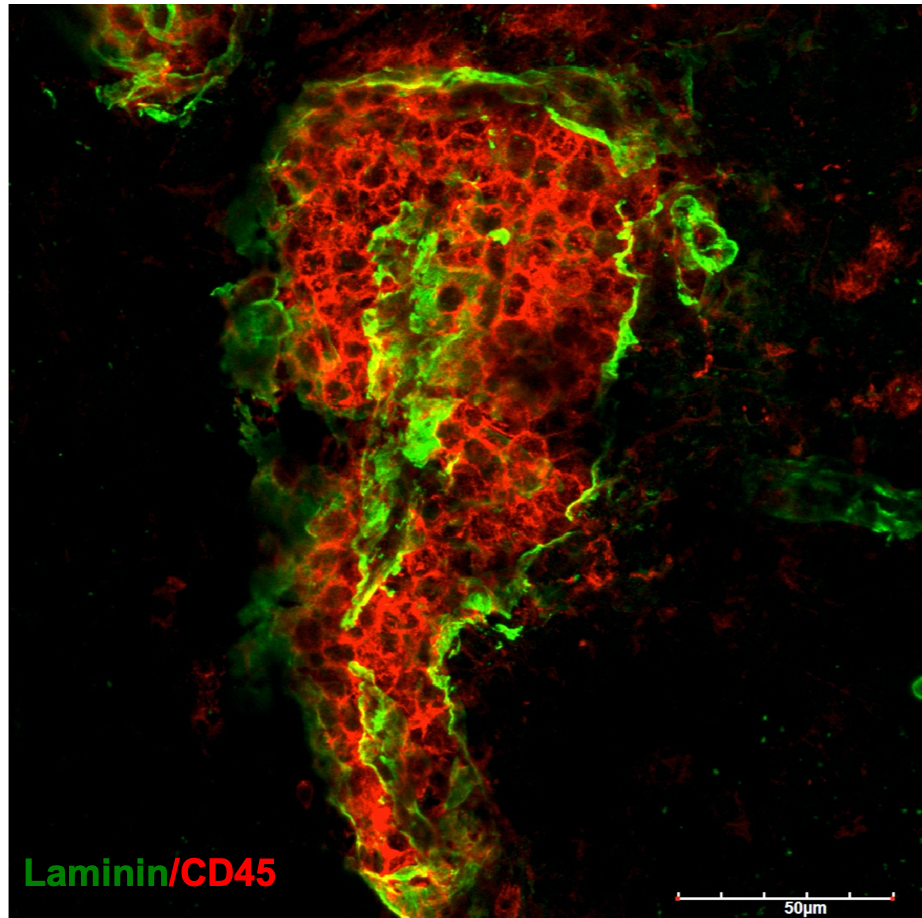
A massive perivascular cuff in EAE mouse cerebellum. Laminin- basement membranes, CD45-Immune cells
Deepak Kaushik
Investigating EMMPRIN as a mediator of MS pathology
I am researching the mechanisms of leukocyte trafficking into the brain during multiple sclerosis (MS) pathogenesis. Using the Experimental Autoimmune Encephalomyelitis (EAE) mouse model for MS, I am working on a project pertaining to understanding the metabolic requirements and its underlying mechanisms within myeloid cells in EAE/MS. In this regard, I am investigating the role of Extracellular Matrix Metalloproteinase Inducer (EMMPRIN) in governing enhanced glycolysis in pro-inflammatory myeloid cells. Using genetic tools to conditionally ablate EMMPRIN from CCR2+ monocytes (CCR2Cretm:EMMPRINfl/fl mice), I am currently studying its involvement in mediating EAE/MS pathology. In addition to my interests in monocyte/macrophages, I am also looking into the pathogenic role of pericytes and astrocytes.
Researcher: Deepak Kaushik
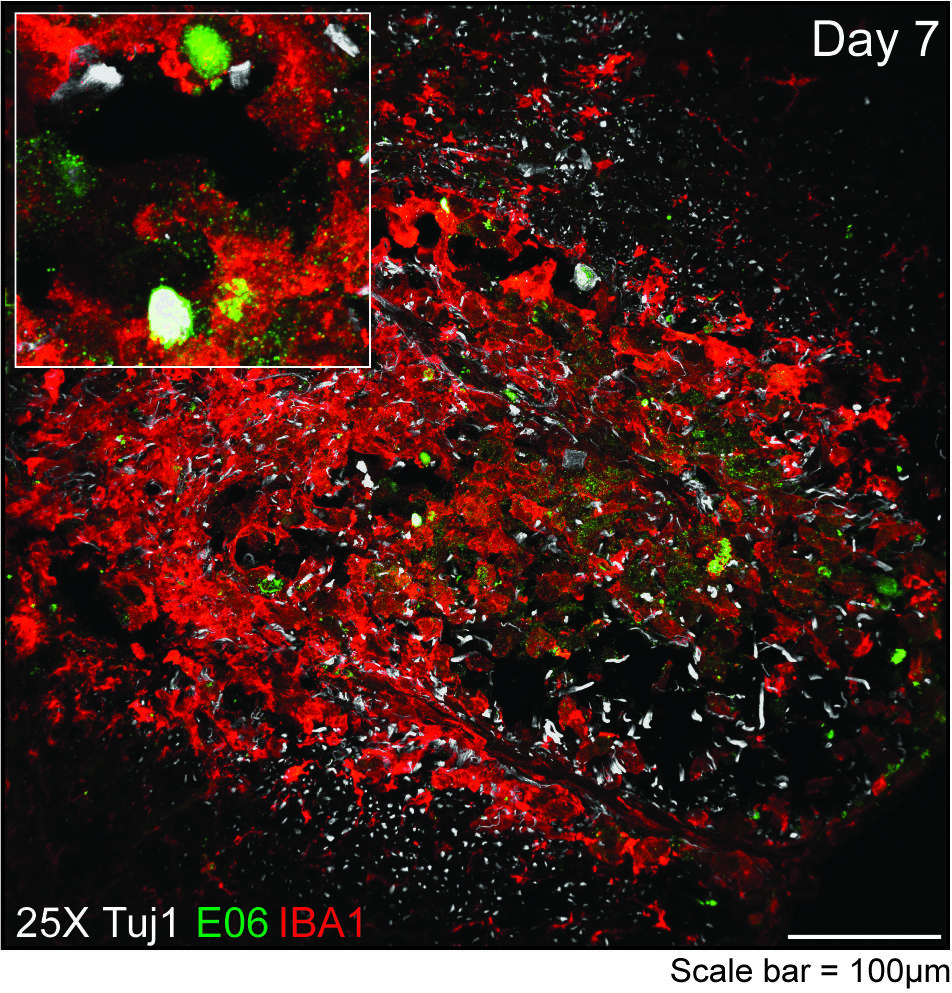
The image is showing axons surrounded by OxPC in the POVPC lesion
Jeff Dong
Understanding how oxidized phosphatidylcholine promote neurodegeneration and contribute to MS.
MS is an incurable autoimmune disease of the brain and spinal cord. Patients are affected by deteriorating MS for life. We aim to study new molecules that cause nerve destruction during MS and to discover better treatments for all patients. During MS, inflammation and myelin loss around neurons can result in the production of harmful molecules such as oxidized lipid molecules, which are reactive and can kill cells to cause permanent tissue damage. It is therefore important to understand the biology of these reactive lipid molecules in MS lesions, and how their removal by immune cells such as the microglia can slow or stop disease progression. As MS is a life-long disease, it is also important to evaluate if the ability of immune cells to remove oxidized lipid molecules worsens with aging and disease progression, and if so, how this process may be rejuvenated. Thus, we propose new models to interrogate the harmful consequences of reactive lipid molecules in the central nervous system and the capacity of immune cells to help their clearance. We will also test for promising therapeutic targets and aim to repurpose cost-effective generic medications such as indapamide to promote neuroprotection from these oxidized lipid molecules.
Researcher: Jeff Dong
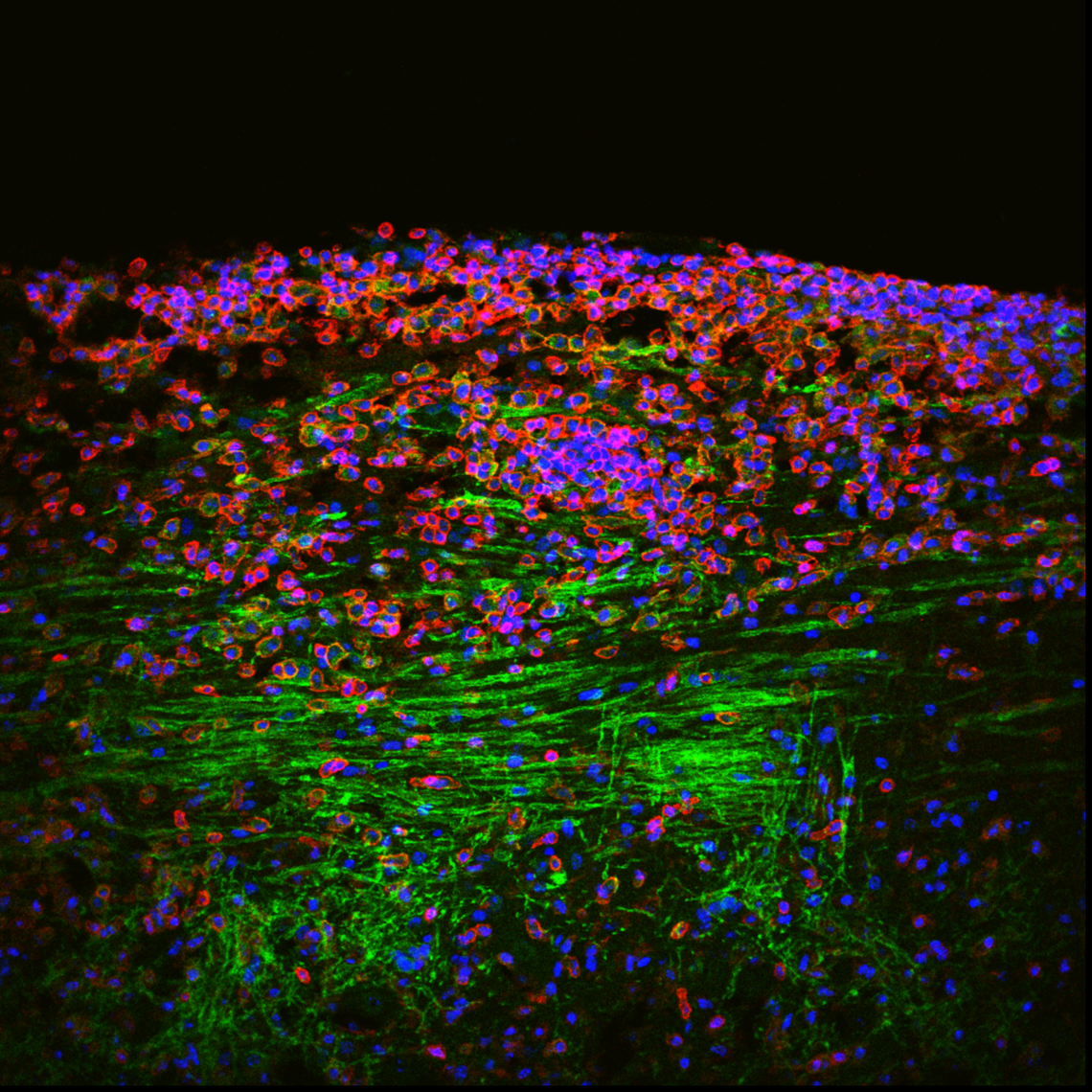
An EAE lesion in NG2-Cre:Tau-mGFP mice. CD45+ cells are labelled as red and GFP expression can be seen in green.
Samira Ghorbanigazar
Promoting Remyelination in Experimental Autoimmune Encephalomyelitis
Remyelination in multiple sclerosis (MS) can restore physical function and exert a neuroprotective role. Due to various causes, remyelination becomes gradually insufficient in most patients. Since chondroitin sulfate proteoglycans (CSPGs) deposited into the lesion microenvironment inhibit remyelination, blocking their synthesis after demyelination could improve tissue repair. Using a recently described transgenic mouse line, we will be able to label and follow the fate of newly formed oligodendrocytes in lesions and monitor remyelination in experimental autoimmune encephalomyelitis (EAE), which recapitulates many features of MS pathogenesis. We will unravel the role of CSPG on remyelination through promoting Th17 responses and determine the effect of inhibiting CSPG synthesis on repair in EAE, thereby proposing a novel therapy for MS. We hope to develop a CNS-targeted therapy to reduce the side effects of CSPG synthesis blocker.
Researcher: Samira Ghorbanigazar
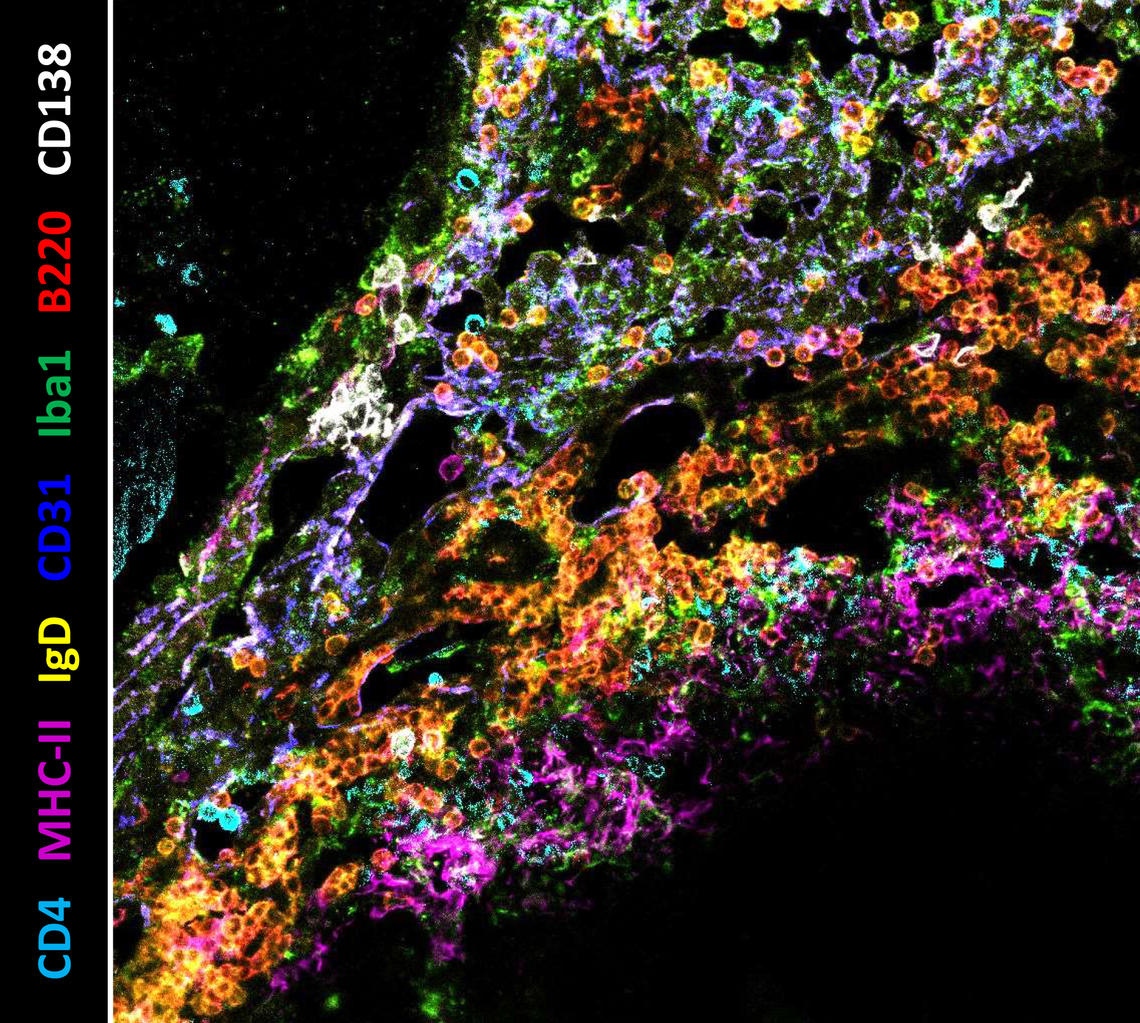
Plasma cells (CD138) localized in the subcapsular sinus (CD31) lined with macrophage (Iba1). B cell follicle filled with B cells (B220) that are primarily naive (IgD). T cell zone tilled with CD4+ T cell (CD4) and dendritic cells (MHC-II).
Rajiv Jain
Identifying pathogenic B cell subsets and their mechanisms in MS lesions
B cells can promote and suppress the progression of MS but we currently do not know which subsets of B cells exist in the brain, their locations in the brain, or the mechanisms that B cells are using to modulate MS progression. In my project, I will address these problems by fully characterizing the locations and subsets of B cells in MS lesions. Using an animal model and cells in culture, I will identify the major mechanism(s) that B cells are using to promote or suppress CNS damage and determine whether cellular interactions in MS lesions influence B cell pathogenesis.
Researcher: Rajiv Jain

Lysolecithin lesion at day 7 stain for pericytes, oligodendrocytes and OPC. Cyan – Olig2 (oligodendrocytes), Green – PDGFRα (oligodendrocyte progenitor cells), Magenta – PDGFRβ (pericytes)
Brian Lozinski
Exercise, aging, and the regenerative environment in demyelinating lesions
Multiple sclerosis is an inflammatory demyelinating disease of the central nervous system. Parenchymal demyelination begins perivascularly and continues outward from there. Pericytes are cells that sit at the junction of the blood-brain barrier and have important roles in regulating this barrier, including immune cell trafficking. In pericyte depletion studies, it has been shown that pericyte loss can lead to neurodegeneration and white matter dysfunction. In my project, I am aiming to characterize the pericyte response following demyelination using the lysolecithin model, understanding the mechanisms of interaction between pericytes and cells such as Oligodendrocyte progenitor cells that are critical for regeneration, and to study how this is affected by both aging and exercise. Pericytes occupy a critical niche at the border of the blood-brain barrier that allows them to control and mediate neuroinflammation. Despite their position in the neurovascular niche, they remain understudied, but an intriguing therapeutic target.
Researcher: Brian Lozinski
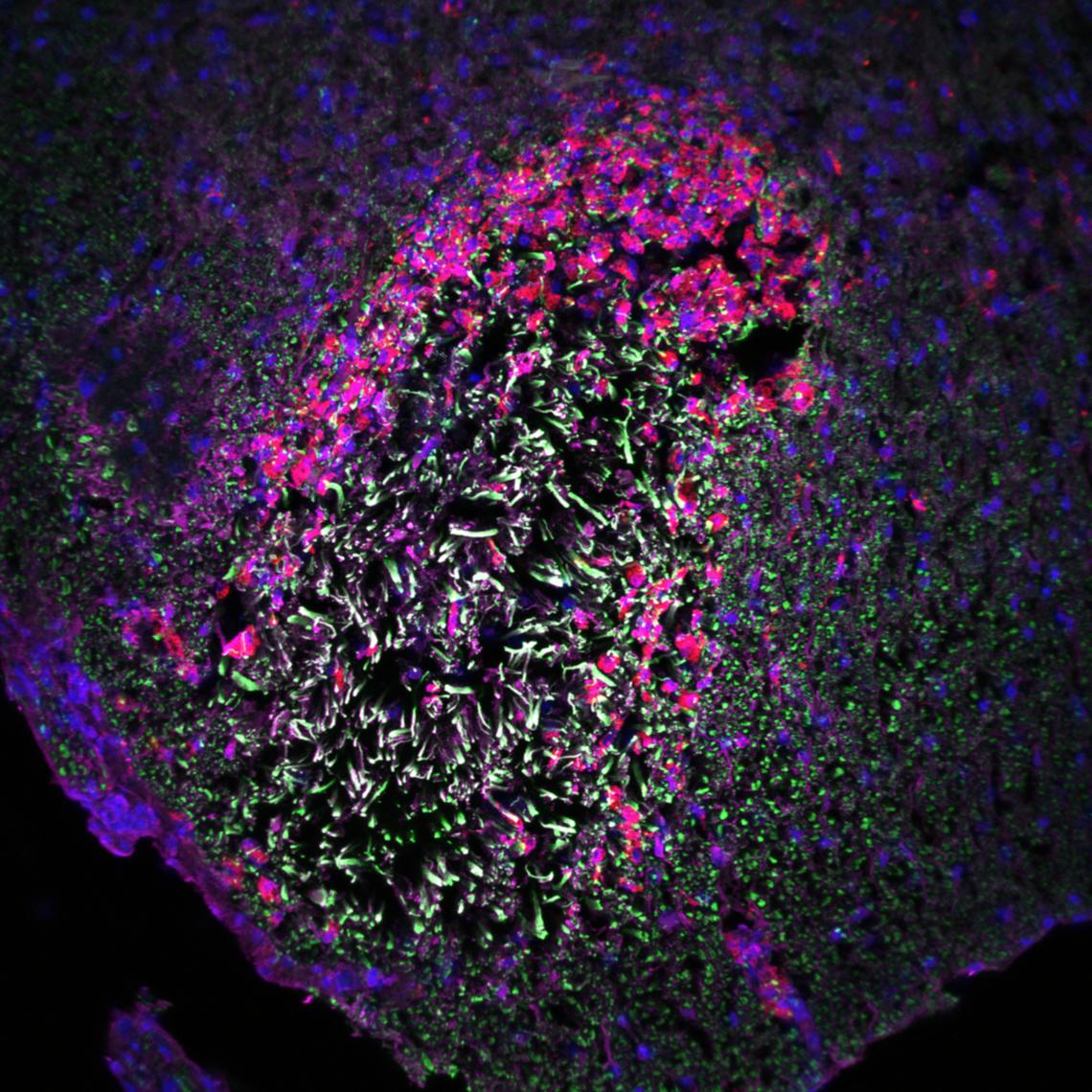
Inflammation and neuronal damage in day 3 lysolecithin lesion in mouse spinal cord white matter. CD68 in red for microglia/macrophage. Neurofilament (NFH) in green for axons. Amyloid precursor protein in magenta. Captured at 25x on SP8.
Dennis Brown
Novel drug combination to attenuate neurodegeneration in an MS model
Current treatments for MS focus on relapse-remitting MS, in contrast to primary progressive MS (PPMS), which skips the relapse-remitting phase and disease immediately begins to progress. With a lack of current treatment options for PPMS, my research seeks to unveil an effective and affordable treatment for the PPMS population. We will investigate two inexpensive generic drugs: Indapamide, a high blood pressure medication and antioxidant, and Hydroxychloroquine (HCQ), an anti-malarial drug known to inhibit microglia, an immune cell of which increased activation is a hallmark of PPMS. Over-activation of microglia results in the degradation of myelin, an insulator surrounding nerve cells, along with myelin-producing cells. This breakdown releases molecules contributing to free radical formation, thus enhancing the risk of disease progression. Using in vitro models along with the lysolecithin mouse model of MS, we will observe the effects that the combination of these drugs has on neuron and oligodendrocyte protection, demyelination, and inflammation. With HCQ currently in a Phase 2 clinical trial for PPMS and indapamide demonstrating promising effects on free radicals in animals, there is optimism that in combination the drugs will have strong therapeutic potential, giving rise to a new treatment plan to fill the void that currently exists for PPMS.
Researcher: Dennis Brown
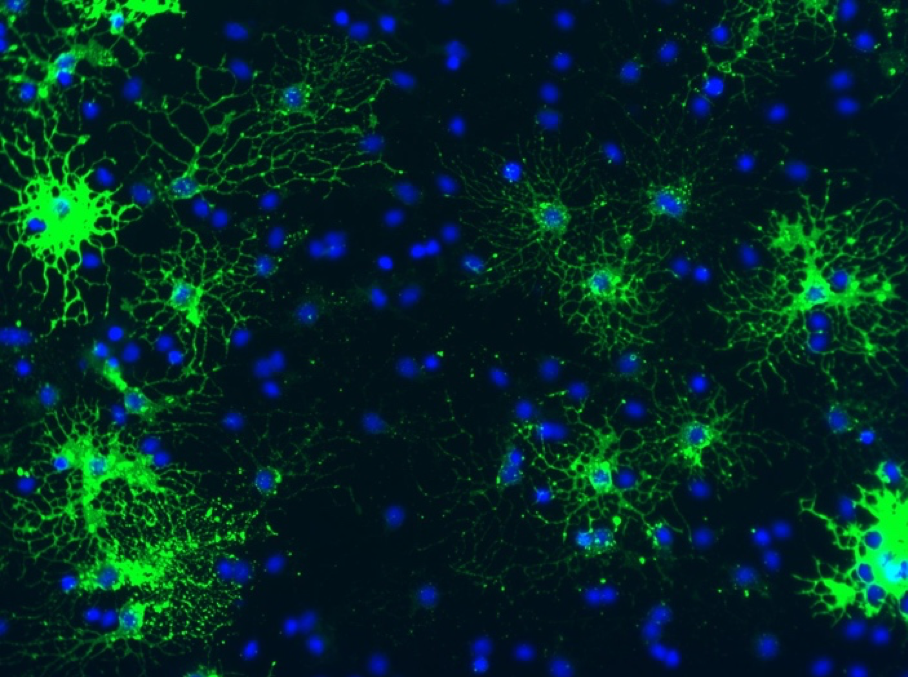
Isolated oligodendrocyte precursor cells from P1 mouse pups with Alexa 488 for O4 in green and DAPI staining for nuclei in blue. Imaged at 20x on ImageExpress.
Emily Jelinek
Versican V1 as a primary inhibitor of remyelination in multiple sclerosis
Following myelin destruction, the brain has an innate repair system in which immature cells called oligodendrocyte precursor cells (OPCs) migrate to the lesion, develop into mature cells, and replace the damaged myelin. There is an inhibitory environment in the MS lesion that prevents OPCs from entering and maturing into myelin-forming cells. The aim of my research is to overcome this inhibitory environment with a focus on chondroitin sulphate proteoglycans (CSPGs). I am studying a particular CSPG member in the CNS called versican V1. Versican V1 is of interest because while high during CNS development, it is not seen in the adult CNS until injury. My work involves tissue culture work and experiments with a transgenic mouse line. My hypothesis is that CSPGs, particularly versican V1, physically restrain process elongation, proliferation, migration and maturation of plated OPCs, and that the conditional removal of versican V1 in lesions will lead to enhanced OPC numbers and remyelination. There are no current therapeutic approaches to induce remyelination in MS and this study hopes to shed light on the most important inhibitor of OPCs and propose a specific targeting strategy that is permissive of remyelination.
Researcher: Emily Jelinek
